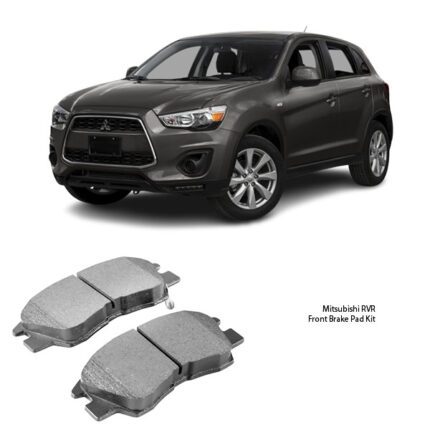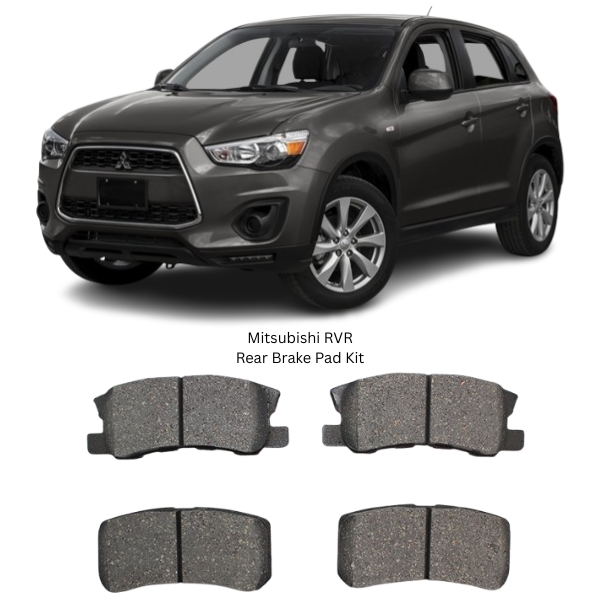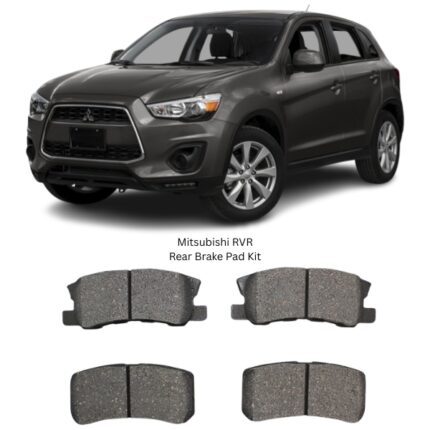Get Mitsubishi RVR Rear Brake Pad Kit D6106 in Kenya
The Rear Brake Pad Kit is one of the most important components in a vehicle’s braking system. Its role is to ensure safe, reliable, and consistent stopping performance under various driving conditions. While small in size compared to other parts of a vehicle, rear brake pads play a critical role in safety by converting kinetic energy into heat through friction. A well-designed kit ensures not only effective braking but also enhanced comfort, noise reduction, and longevity of the braking system.
Function and Role in the Braking System
When a driver presses the brake pedal, hydraulic pressure is generated within the braking system. This pressure pushes the caliper pistons, which in turn press the brake pads against the rotating brake discs (or rotors). The friction material on the brake pads makes direct contact with the disc, slowing down and eventually stopping the vehicle.
The rear brake pads complement the front brake pads, sharing braking forces to maintain stability. While front brakes typically handle more of the stopping power due to weight transfer, the rear pads ensure balanced performance and prevent the rear of the vehicle from swaying or skidding during sudden braking.
Kit Components
A standard Rear Brake Pad Kit typically includes:
-
Brake Pads (LH/RH): The friction material assemblies that press against the disc.
-
Anti-Rattle Clips or Shims: Reduce noise, vibrations, and harshness by keeping the pads stable.
-
Wear Indicators (where applicable): Metal tabs or electronic sensors that signal when the pads are nearing the end of their lifespan.
-
Fitting Hardware: Springs, bolts, or pins to secure the pads within the caliper.
This ensures the kit provides everything needed for proper installation and long-lasting performance.
Design and Construction
Rear brake pads are carefully engineered to withstand high temperatures, heavy loads, and repeated use without losing effectiveness.
Key design elements include:
-
Friction Material: The specialized compound that makes contact with the disc. Materials vary from semi-metallic, ceramic, or organic formulations.
-
Steel Backing Plate: Provides structural strength, ensuring the pad retains its shape and remains secure during braking.
-
Bonding/Attachment Method: High-temperature adhesive or mechanical retention methods secure the friction material to the backing plate.
-
Chamfers and Slots: Cutouts in the friction material that reduce noise, prevent cracking, and improve heat dissipation.
-
Shims and Insulators: Reduce vibrations and minimize squealing or grinding sounds.
Types of Friction Materials
-
Semi-Metallic Pads
-
Contain metal fibers mixed with other materials.
-
Known for strong braking power and heat resistance.
-
May produce more dust and noise than alternatives.
-
-
Ceramic Pads
-
Made from ceramic fibers and bonding agents.
-
Offer quiet operation, low dust production, and long life.
-
Excellent for smooth and consistent braking under normal conditions.
-
-
Organic/Non-Asbestos Pads (NAO)
-
Made from natural fibers, rubber, and resins.
-
Softer on rotors, quieter, and environmentally friendly.
-
May wear faster under heavy use.
-
Each type is selected based on performance needs, driving environment, and comfort preference.
Performance Features
A high-quality Rear Brake Pad Kit delivers:
-
Consistent Stopping Power: Reliable performance in both everyday driving and emergency stops.
-
Heat Resistance: Withstands high friction temperatures without fading.
-
Durability: Long lifespan, reducing the need for frequent replacements.
-
Low Noise and Vibration: Engineered with shims and slots for quieter operation.
-
Rotor Compatibility: Designed to work without excessive wear on the brake discs.
-
Smooth Pedal Feel: Provides predictable braking response and comfort for the driver.
Signs of Worn Rear Brake Pads
Timely replacement of rear brake pads is critical for safety. Common warning signs include:
-
Squealing or Screeching Noise: Caused by wear indicators contacting the rotor.
-
Grinding Sound: Indicates the friction material is completely worn, exposing the metal backing plate.
-
Reduced Braking Performance: Longer stopping distances or weak pedal response.
-
Warning Lights: Some vehicles have dashboard alerts when pads are low.
-
Vibration or Pulsation: Uneven wear or warped rotors can cause shaking when braking.
Ignoring these signs can damage rotors, increase repair costs, and compromise safety.
Maintenance and Replacement Intervals
Brake pad life varies depending on driving style, road conditions, and load. On average, rear pads last between 30,000 to 70,000 km. Aggressive driving, stop-and-go traffic, or frequent towing can shorten this lifespan.
Maintenance tips:
-
Inspect brake pads regularly during servicing.
-
Replace pads when friction material reaches the minimum recommended thickness (often around 3mm).
-
Always replace pads in axle pairs (both left and right rear) to maintain balance.
-
Check brake fluid levels and condition during pad replacement.
Installation Process
Replacing a rear brake pad kit requires precision:
-
Lift the Vehicle Safely: Use a jack and secure with stands.
-
Remove Wheel Assembly: Expose the brake caliper and disc.
-
Detach Caliper: Loosen bolts and slide caliper off the disc.
-
Remove Old Pads: Take out worn pads and inspect caliper hardware.
-
Install New Pads and Hardware: Fit shims, clips, or springs as supplied in the kit.
-
Reinstall Caliper: Compress the piston if necessary and secure bolts.
-
Check Brake Fluid: Top up if required.
-
Test Brakes: Gently press the brake pedal before driving to seat pads properly.
Bedding-In Procedure
New brake pads require a bedding-in process to achieve optimal performance:
-
Perform several moderate stops from 50–60 km/h down to 10–15 km/h.
-
Avoid hard or emergency braking during the first 200–300 km.
-
This ensures proper transfer of friction material onto the rotor for maximum grip and minimal wear.
Safety and Environmental Considerations
-
Safe Disposal: Old brake pads must be disposed of properly as they may contain metallic dust or other waste materials.
-
Heat Management: Avoid driving with constant braking to prevent overheating and brake fade.
-
Eco-Friendly Options: Modern pads are free from asbestos, reducing environmental hazards.
Impact on Driving Experience
The rear brake pad kit contributes directly to:
-
Safety: Reliable stopping power reduces accident risk.
-
Comfort: Smooth, quiet operation improves driving experience.
-
Efficiency: Well-maintained brakes reduce strain on other braking components.
-
Longevity: Prevents rotor damage and extends overall braking system life.
Follow us on Facebook for more parts.




